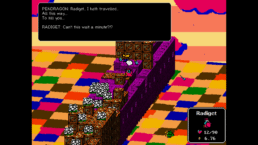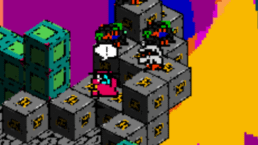thecatamites' Magic Wand
Nilson Carroll
If indie game designer thecatamites’ seminal JRPG punk-nightmare Space Funeral (2010) is The Velvet Undergound & Nico of weird/outsider games (“everyone who played Space Funeral started making a game”), then how should we consider their fantasy RPG Magic Wand, a massive 3D fantasy world built in Unity that also uses the language of Japanese role-playing games to a subverted end?
Once more lost amid the barren plains
his noble spirit spent upon unamiable subsistence
good Radiget searches for his friends.
Upon booting up the adventure, a few things are immediately clear: the gameplay elements act as an aesthetic choice rather than function as variables in a win/lose system. It never matters how much health the player character, Radiget, currently has, or if he pokes the relentless villains on his trail with his sword. Magic Wand focuses instead on questioning the sequences of role-playing games, the kinds of spirits, sprites, and sociopaths the player might meet, the motions of the quest, all its colors, poetic and absurd.

As the player continues their quest, Magic Wand actively disrupts the video game myth/trope of “destiny,” the idea that events happen in neat narratives and that the player character is designed to be special. This disruption evolves into a subversion of the entire concept that “things are going to happen” at all, before finally settling at “all things are happening simultaneously.” Within Magic Wand, something is happening.

Poetry arises through conversations with Magic Wand’s disparate cast of misfits. Non-sequiturs and the most brief glimpses into narratives not involving the player build upon each other to create a busy, vibrating dream world. Much of the game’s exchanges with the player involve noticing a flickering sprite in the distance or high above on a platform and weighing the option of time/energy spent in order to hear their joke or incantation. Radiget’s movement can be difficult to control, transforming the usual video game sequence of tricky maneuvering toward gaining power to one of maneuvering toward a secret sharing between player, game, and author. In this way, playing Magic Wand is closer to scouring Ulysses with your friends for jokes than playing Dragon Quest.
Remember, Radi,
you can always sink deeper into the shit!
Wa ha ha ha ha! What kind of lesson is that?!?
See you around!
Recurring characters throughout further add a sense of sequence to the adventure (I avoid the word narrative), a quest to locate an abstract magic item. But what is this adventure about? Most of the dialogue and text is explicitly anti-social, teeming with bad advice, false starts, and unresponsiveness. With these techniques, thecatamites develop a video game texture to run one’s hand (and mind) over, akin to grappling with a Dada poetry anthology, perhaps what Tristan Tzara would have made if he spent the 1990s playing Final Fantasy.

I think back to Space Funeral, which is both an adoring love-note to games and a cynical inquiry of them, a call to arms to make games more poetic, to question their complacent nature. Magic Wand does not bite as hard, but functions as a different kind of gift from the author, a humorous spring daydream birthed in a warm, hazy light.

Magic Wand’s sequences remind me of another work in thecatamite’s 50SHORTGAMES collection, “FF35,” a short piece in which the author pleads to the multi-million dollar game company Square Enix to allow him to make “the next Final Fantasy,” possibly a boyhood (tongue-in-cheek) dream. Full of anxiety, the piece (and the dream) is over as soon as it begins, a desperate shout toward the sky.
Magic Wand by comparison is a literal walk through a park, an hour to breathe and to see the world. It’s the answer to “FF35,” the video game that thecatamites made instead of the next Final Fantasy.
*
Nilson Carroll is an MFA candidate at Visual Studies Workshop in Rochester, NY. A barista-poet, Nilson is currently exploring 16mm expanded cinema, video projection performance, and makes queer video game installations.